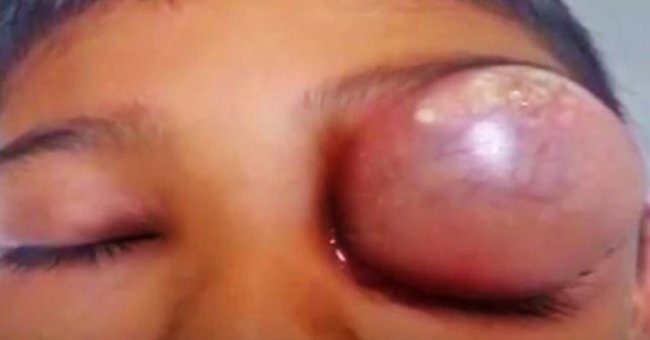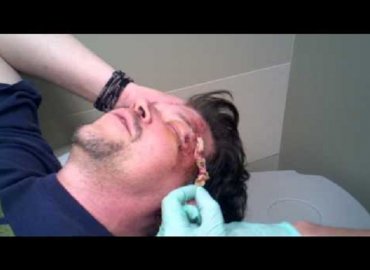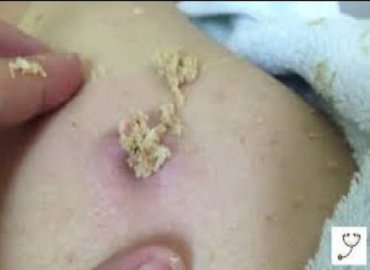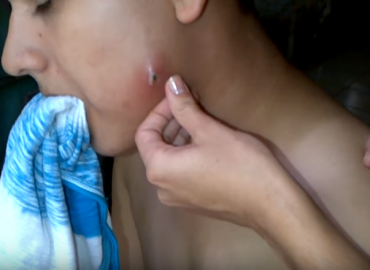While there are many forms of eyelid cysts, most consist of a localized swelling of the eyelid. Some eyelid cysts are caused by an infection, and these can be painful and can even alter a person’s appearance.
If the infection is left untreated long enough, it can affect your vision. Most types of eyelid cysts go away on their own, but others need to be treated with antibiotics or surgery. Only your eye doctor can properly diagnose your cyst and determine the appropriate treatment.
Eyelid Cyst Symptoms
- Lumps on eyelids or around eyes
- Redness
- Tenderness
- Discoloration
- Eye crusting
- Discomfort when blinking
Many people can feel an eyelid cyst forming, but others have no idea when one is developing. If you have any of the symptoms listed above, try your best not to touch or rub your eyes, and make an appointment with your eye doctor.
What Causes Eyelid Cysts to Develop?
 The transfer of dirt, debris, and bacteria into or around your eyes can lead to the formation of these unsightly lumps or cysts. The most common causes of eyelid cysts are:
The transfer of dirt, debris, and bacteria into or around your eyes can lead to the formation of these unsightly lumps or cysts. The most common causes of eyelid cysts are:
- Staph bacteria
- Eye duct/gland blockage
- Poor hygiene
- Dirty contact lenses
- Cosmetics
- Leaving make-up on overnight
- Touching or rubbing eyes, especially with unwashed hands
What Are the Risk Factors for Eyelid Cysts?
Certain risk factors can increase your chances of developing an eyelid cyst. These include:
- History of cysts
- Chronic blepharitis
- Poor personal hygiene
- Chronic skin problems
- Problems with oil gland secretion in eyelids (Meibomian Gland Dysfunction)
How Many Types of Eyelid Cysts Are There?
There are many different types of eyelid cysts, including:
- Stye (also known as a hordeolum): A is an abscess in the oil glands, and is one of the most common forms of eyelid cysts. A stye is an acute infection that causes the cyst to become red, swollen, and tender to touch. If a stye lasts longer than two days you should schedule an appointment with your optometrist or ophthalmologist.
- Chalazia (also known as meibomian cysts): A chalazion is a lump on the eyelid that is commonly the result of an untreated stye. If a stye (infection) is not treated, the bacteria and debris can become a hard ball under the lid called a chalazion. Chalazia are non-infectious, chronic, and can last eight to sixteen weeks. Typically chalazia are not painful or tender, but they may need surgical removal if they do not resolve on their own. This surgery is performed by an ophthalmologist, and it entails cutting the cyst open and removing it.
- Sweat Gland Cysts: These cysts tend to be round, shiny, transparent lumps that appear near the tear ducts. This kind of cyst should be examined by your eye doctor to ensure that it is not something more dangerous, such as a squamous or basal cell carcinoma.
- Keratosis: These cysts are a combination of keratin and tissue and are found in various forms. There are three types of keratosis
- cysts: actinic, seborrheic, and keratosis pilaris.
- Inclusion Cysts: These cysts are white, filled with fluid, and cause a painless swelling of the eyelid. Although they are generally considered to be harmless, they should be examined by an eye care professional.
Should I See an Eye Doctor for an Eyelid Cyst?
If symptoms of an eyelid cyst develop, you should visit an eye doctor who can diagnose the type of cyst you have and determine the cause. Most eyelid cysts can be diagnosed with a complete eye exam.
The eyelids and eyelashes will be examined closely, and your eye doctor will check your eyelid structure, skin, and eyelash appearance. Once a proper diagnosis is made an appropriate treatment plan can be created.
How Are Eyelid Cysts Treated?
If you have a cyst on your eyelid, the best treatment starts with better personal hygiene. Keep your hands and fingers and the area around your eyes clean at all times. Try your best not to touch or rub your eyes.
This can help prevent bacteria from spreading. If you use cosmetics, throw them away and buy new ones after the cyst is gone. This will prevent the spread of bacteria that could be infecting your eye make-up. Avoid sharing your eye make-up, even with those closest to you.
If your eyelid cyst is painful, becoming larger in size, or has lasted a long time, seek medical attention from an optometrist or ophthalmologist.
Your eye doctor will determine the appropriate treatment plan. Common methods of treatment include antibiotics and surgical removal. Your doctor can also show you what steps to take to prevent the cyst from recurring.
A common way to relieve discomfort from a cyst on the eyelid is to apply warm compresses. Hold the compress to the eyelid for five to ten minutes several times a day. Wash your eyelids with baby shampoo diluted with water, or use a commercial product designed to wash eyelids.
Cysts are usually only removed for cosmetic reasons. Rarely do they pose a significant threat to anyone’s overall eye health or vision. Most eyelid cysts do not obstruct vision or pose an immediate problem for the eye. Talk with your eye care provider about possible treatment options for a cyst on the eyelid.
What Is the Prognosis for Eyelid Cysts?
In many cases, the eyelid cyst will go away on its own within a few weeks. On rare occasions, the cyst will enlarge and symptoms will worsen. Cysts can usually be treated effectively, but they may recur in people who are at higher risk.
What Can I Do to Prevent Eyelid Cysts?
Most types of eyelid cysts can be prevented by maintaining basic hygiene habits and by avoiding sharing certain items with others (e.g., towels, make-up, and eye drops). Keeping your hands clean can prevent bacteria from being transferred when you touch your eyes.
If you are prone to a certain type of eyelid cyst, such as chalazia, ask your eye doctor about additional prevention steps.
Talking Your Eye to Doctor
- What can I do to prevent eyelid cysts from recurring?
- Are there any over-the-counter products available to help reduce symptoms?
- What is causing cysts to develop on my eyelids?
- Which type of cyst do I have? Can you tell me a little more about this particular type of cyst?
- Based on the type of cyst I have, what are my treatment options?
- Will I need to see a specialist to have my eyelid cyst removed?







